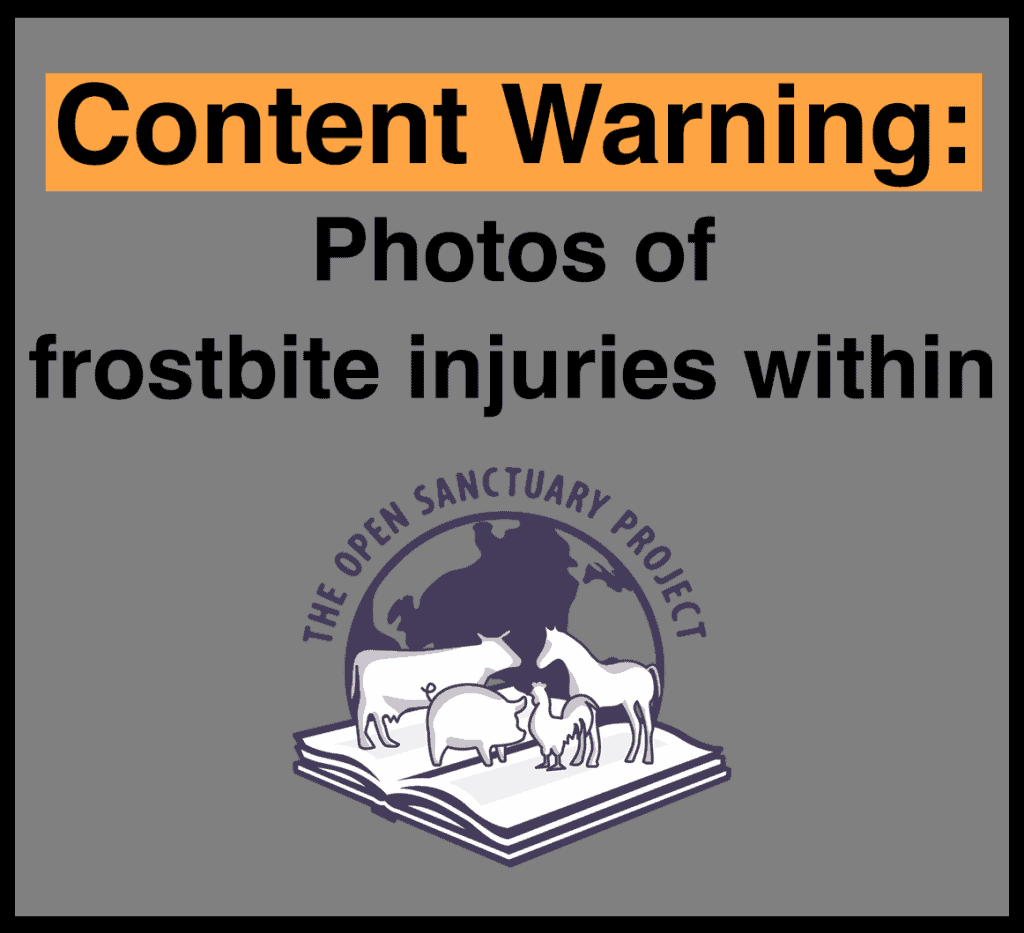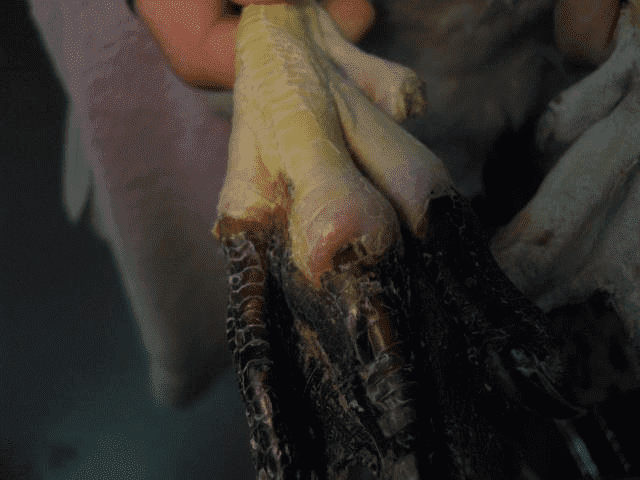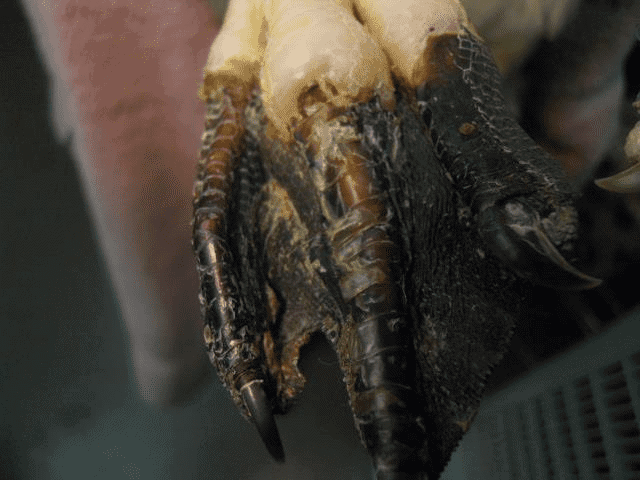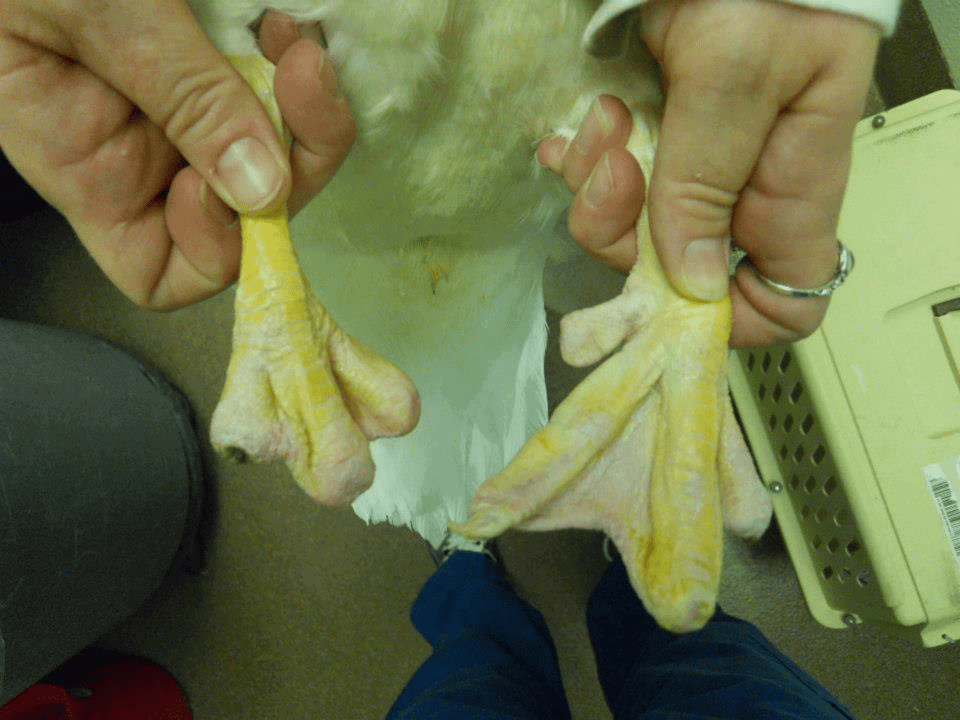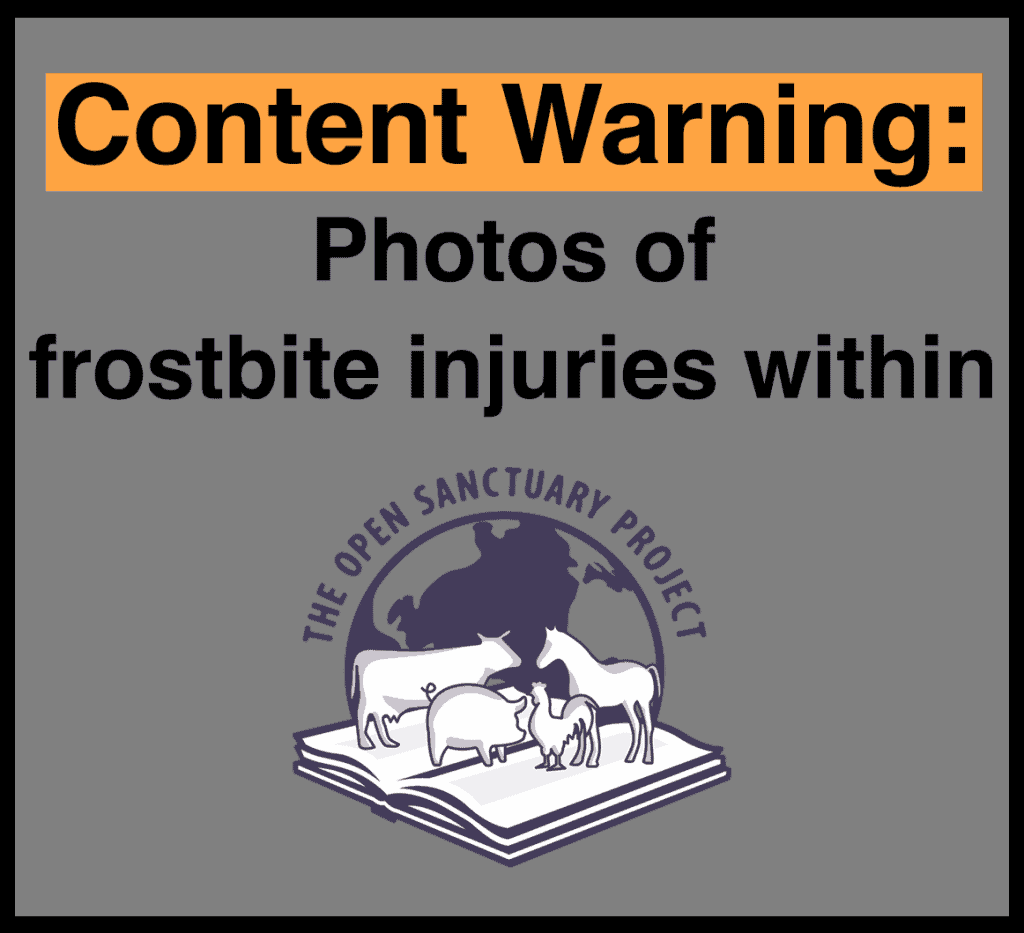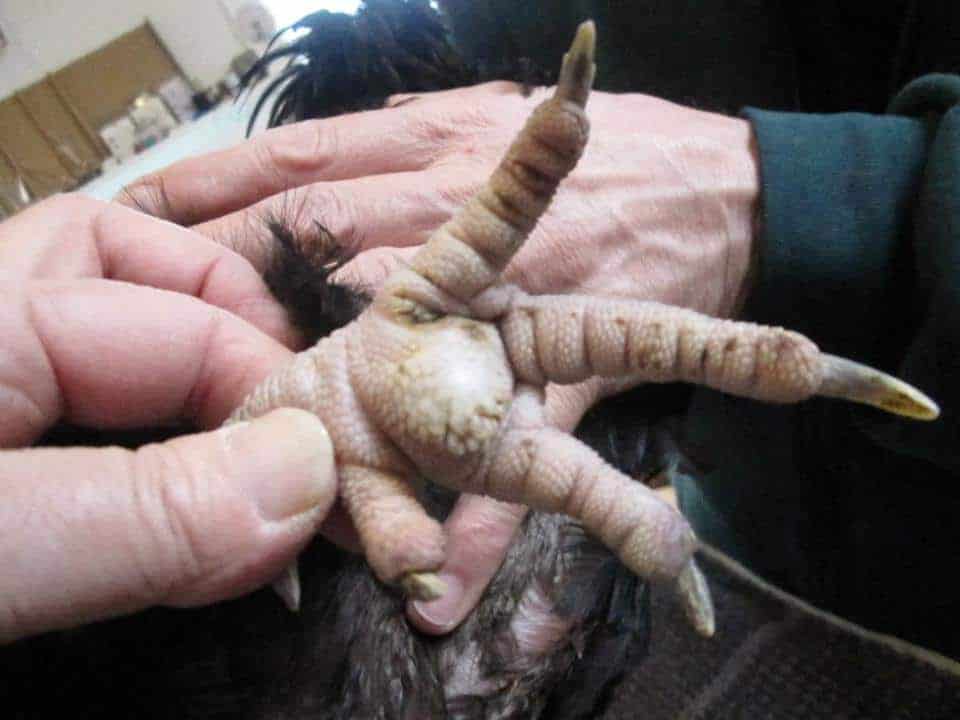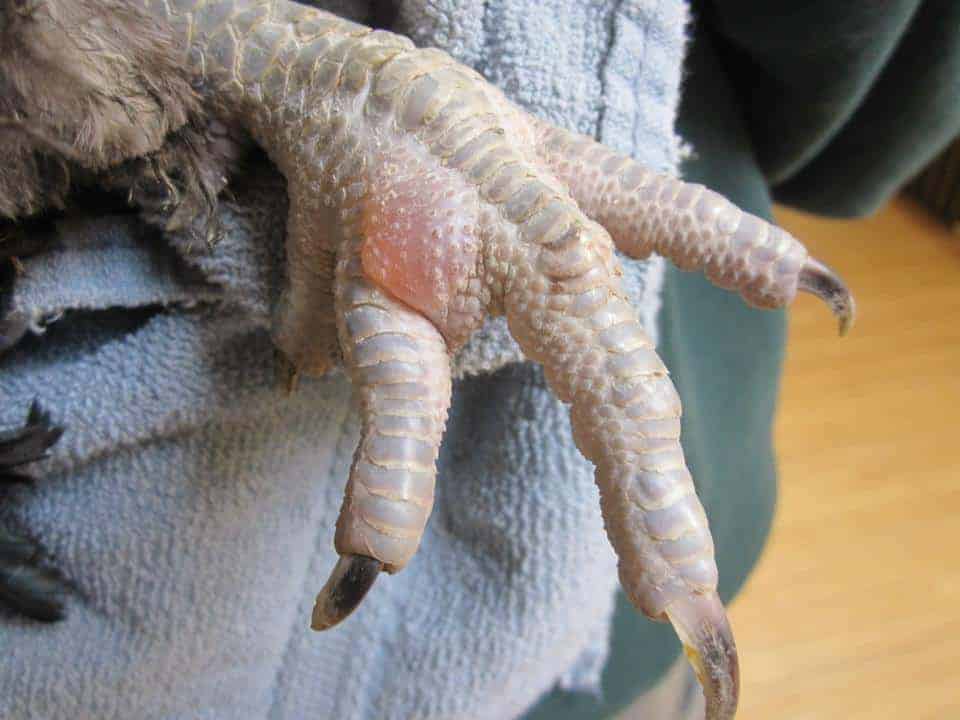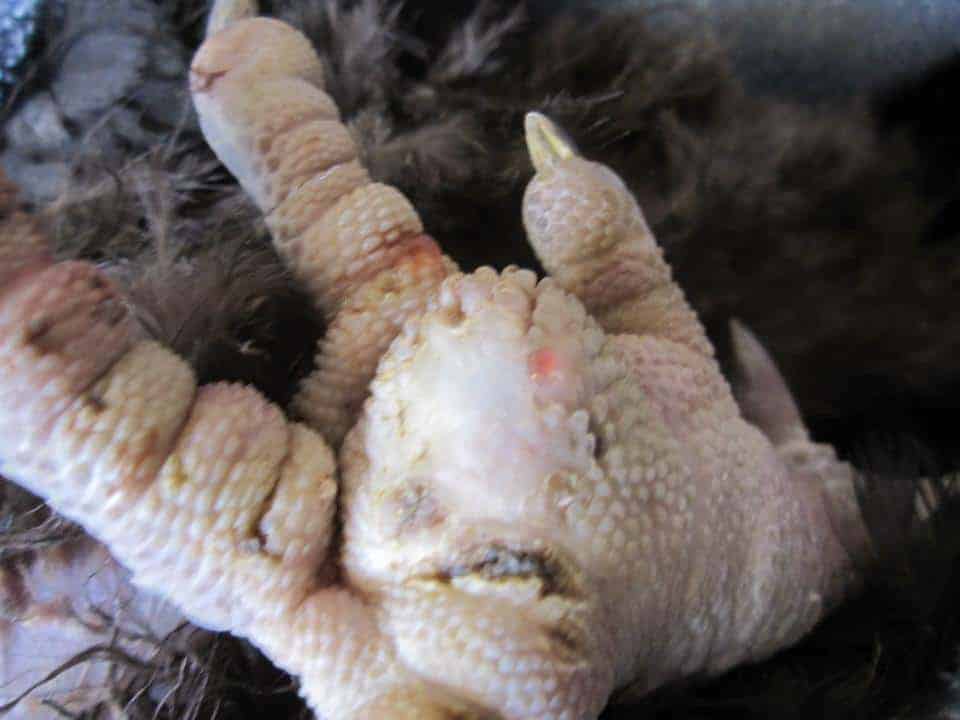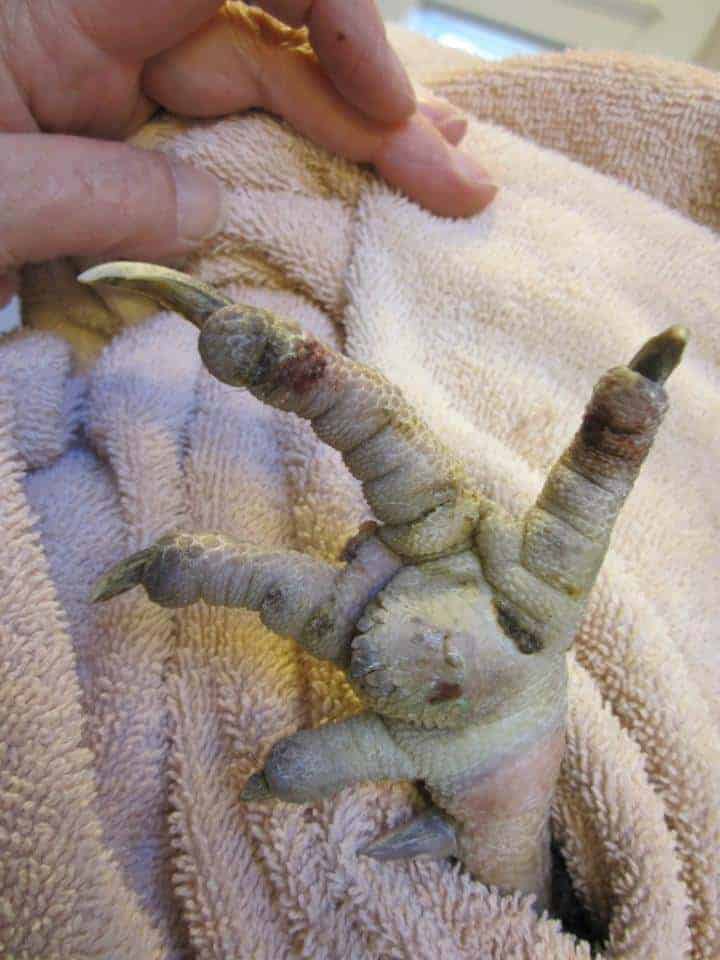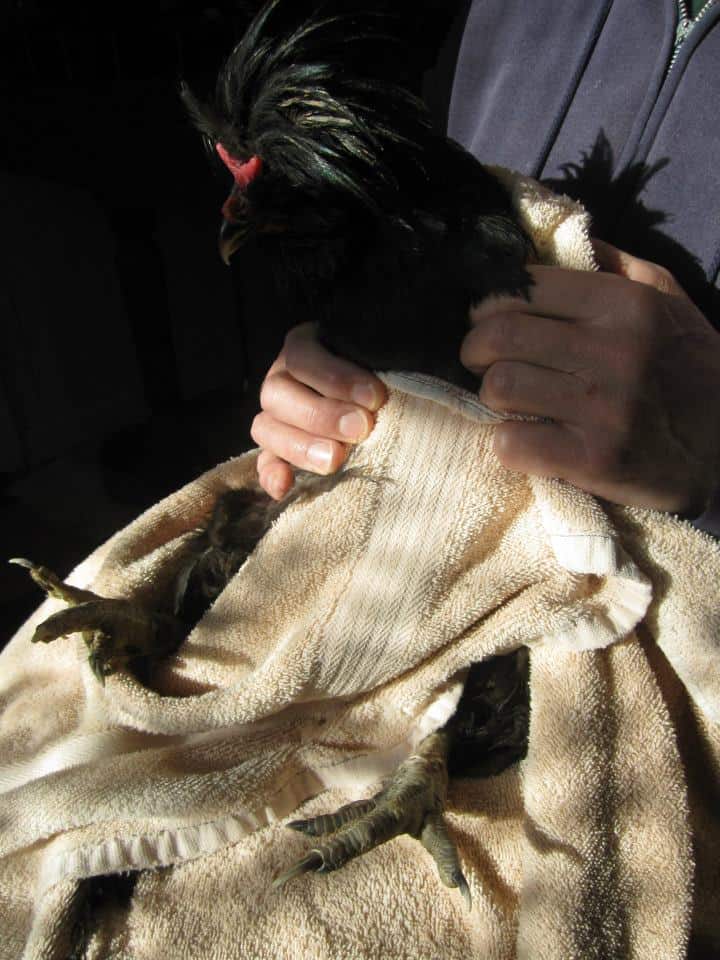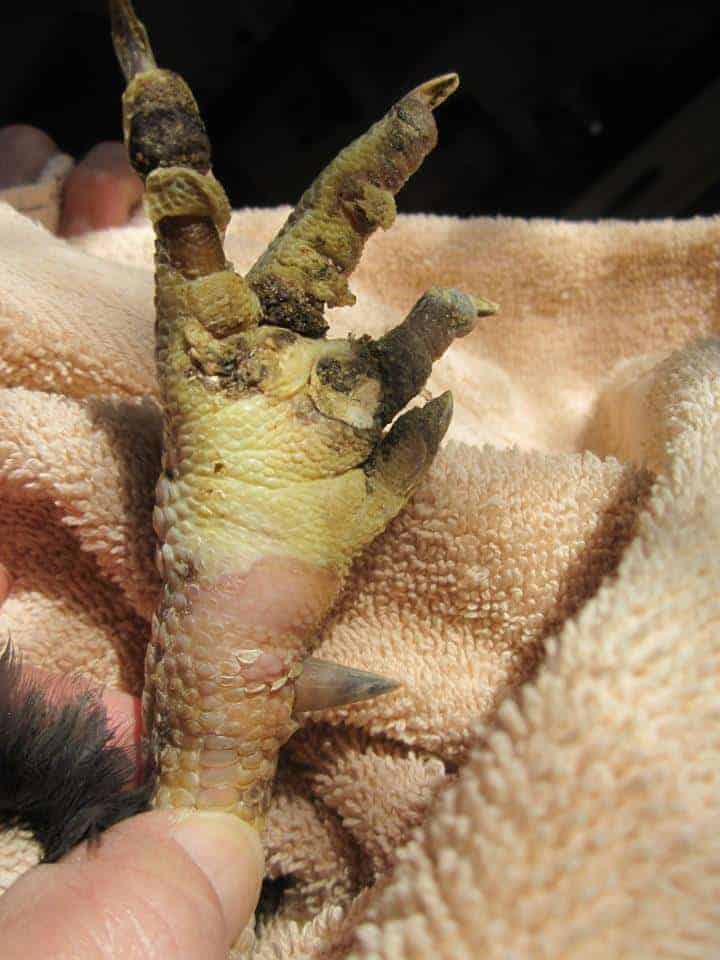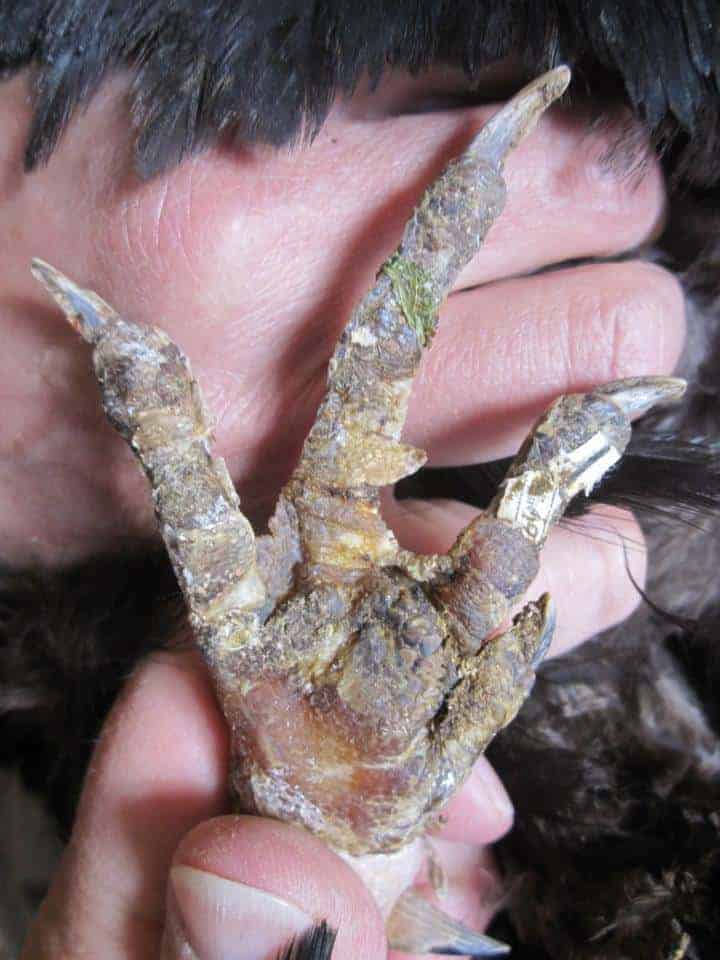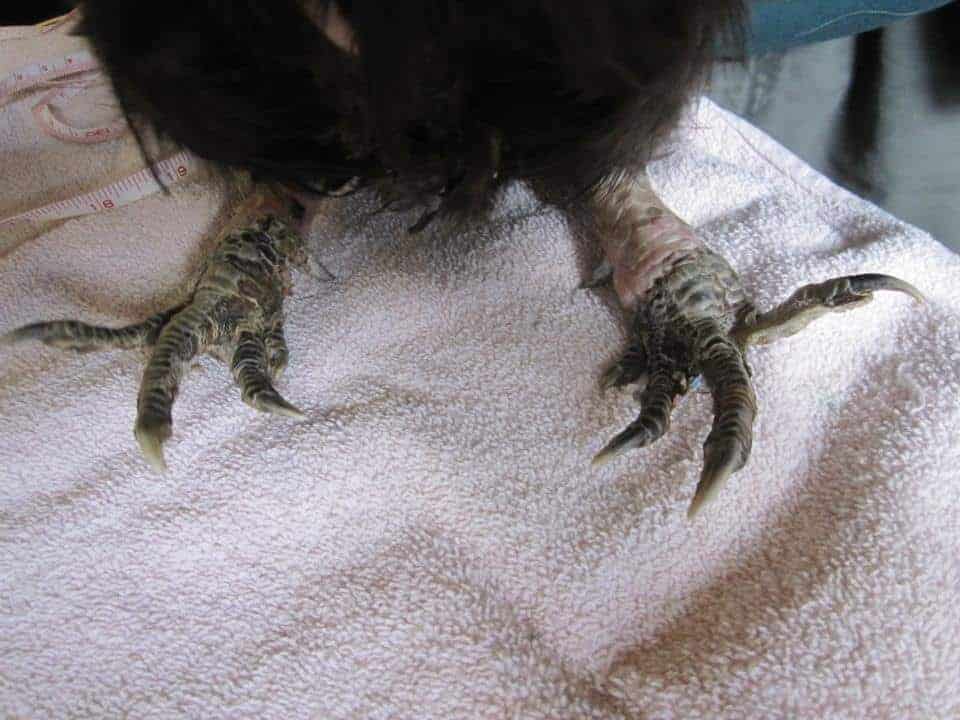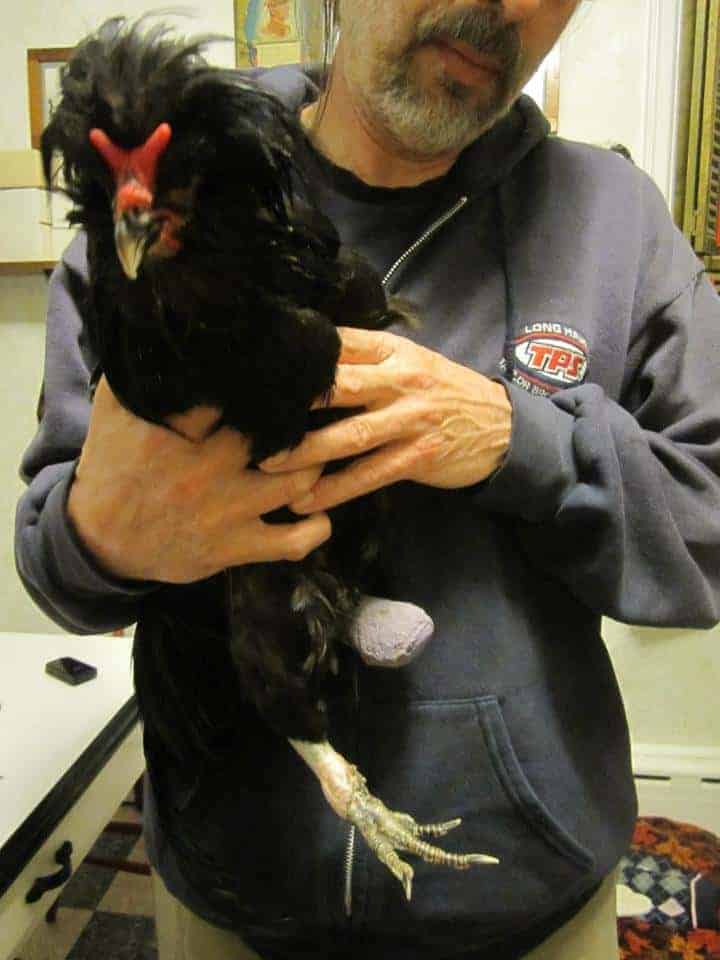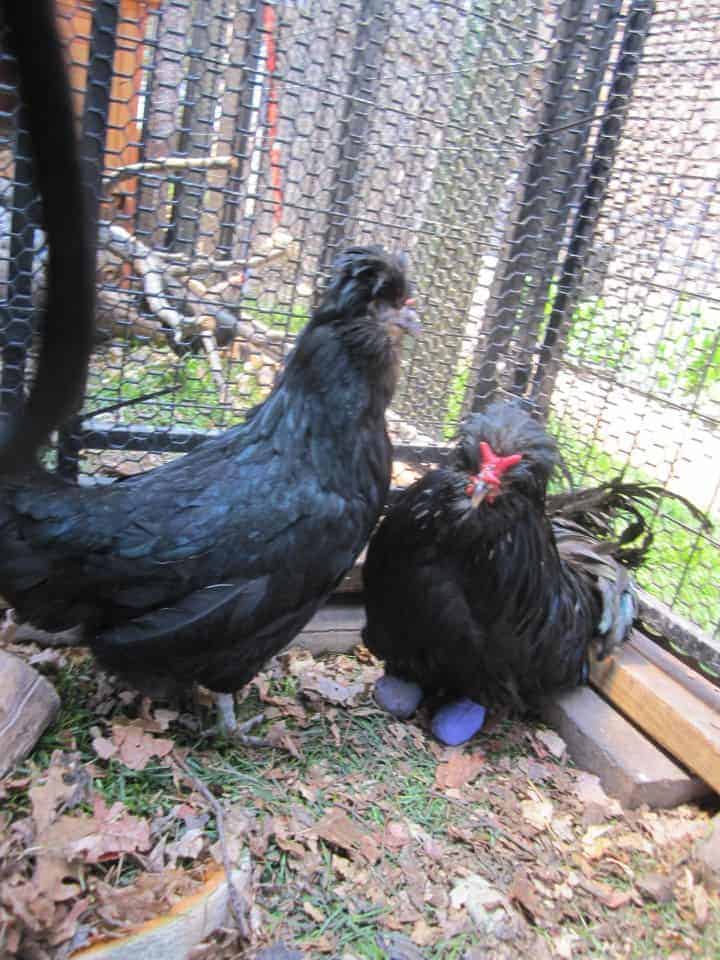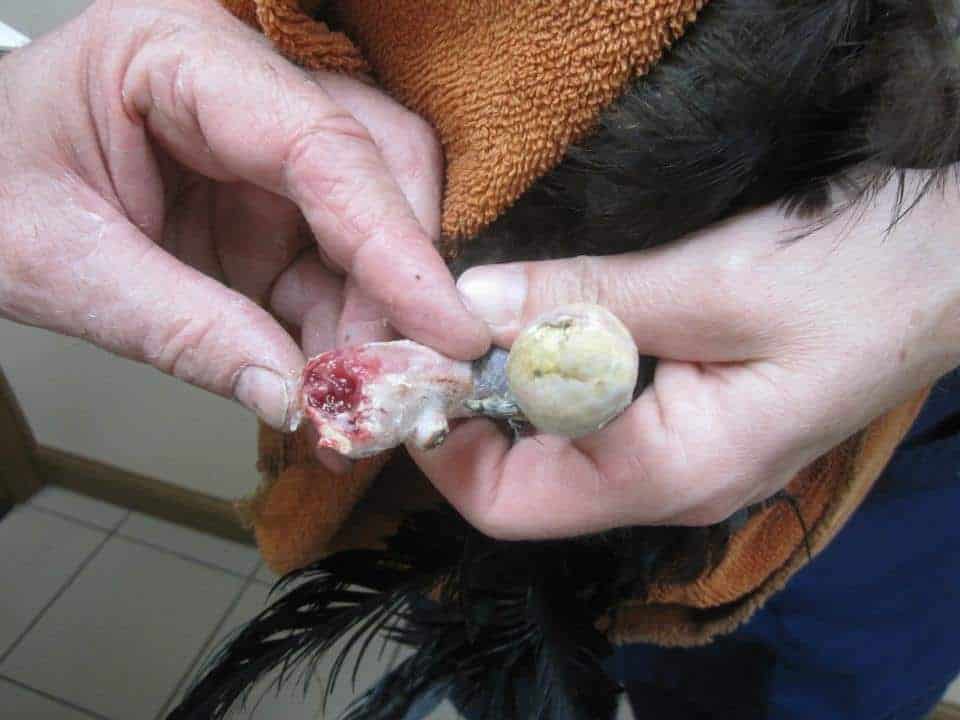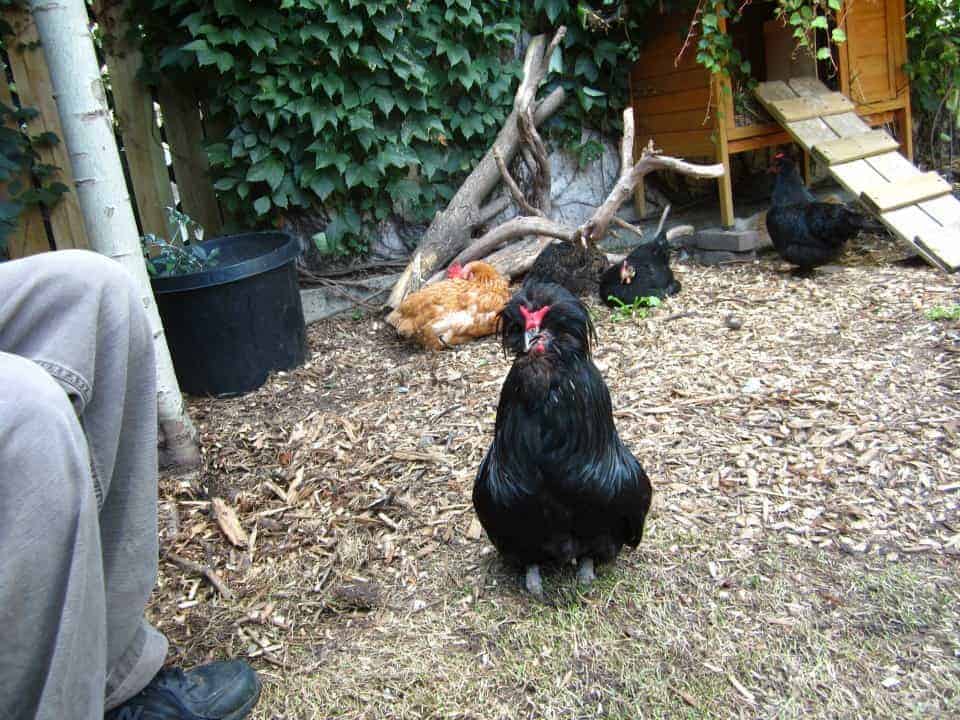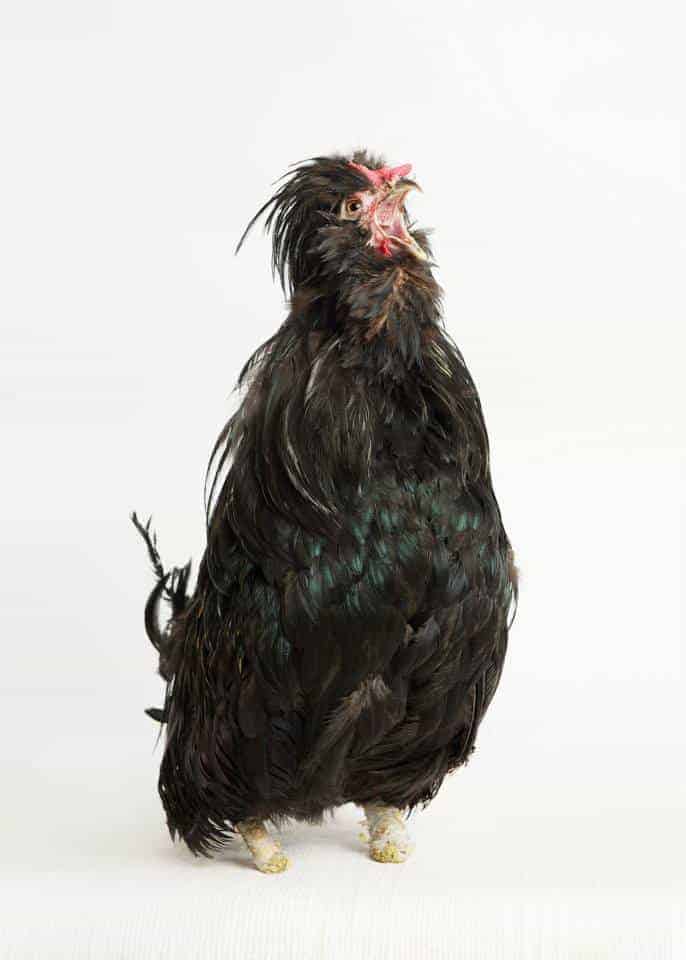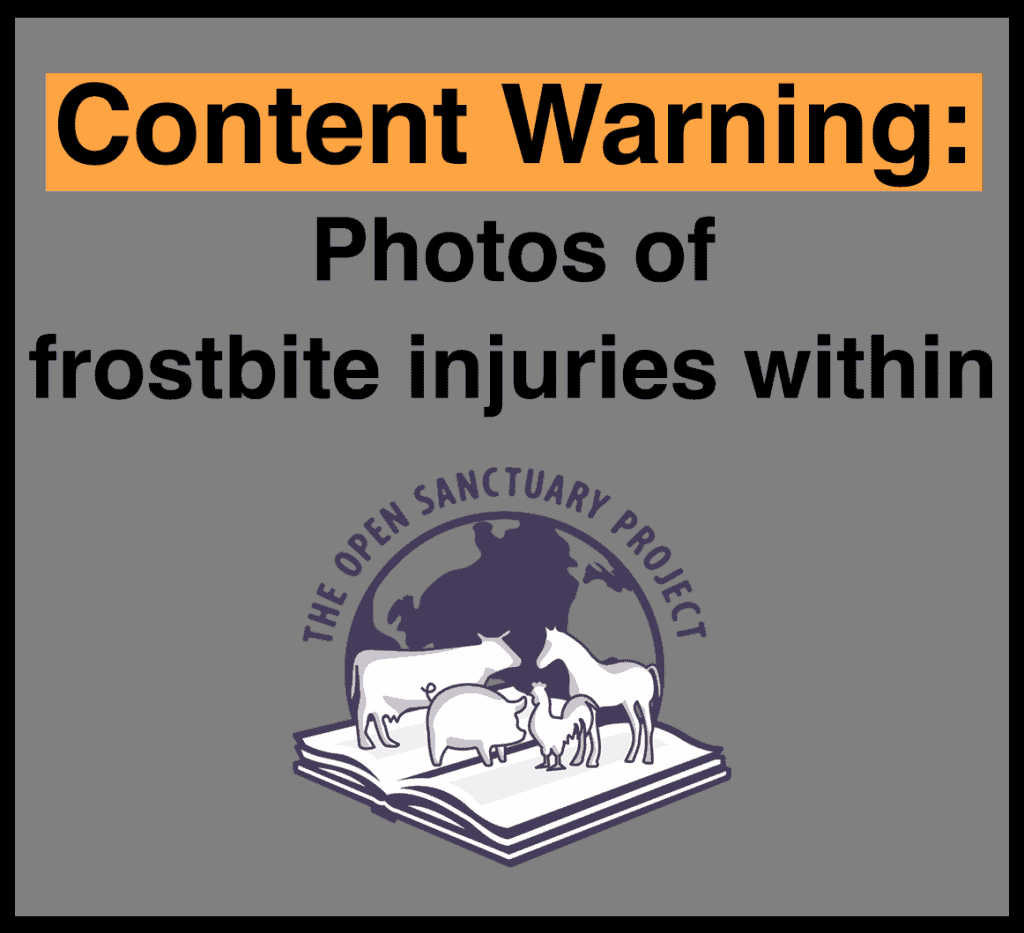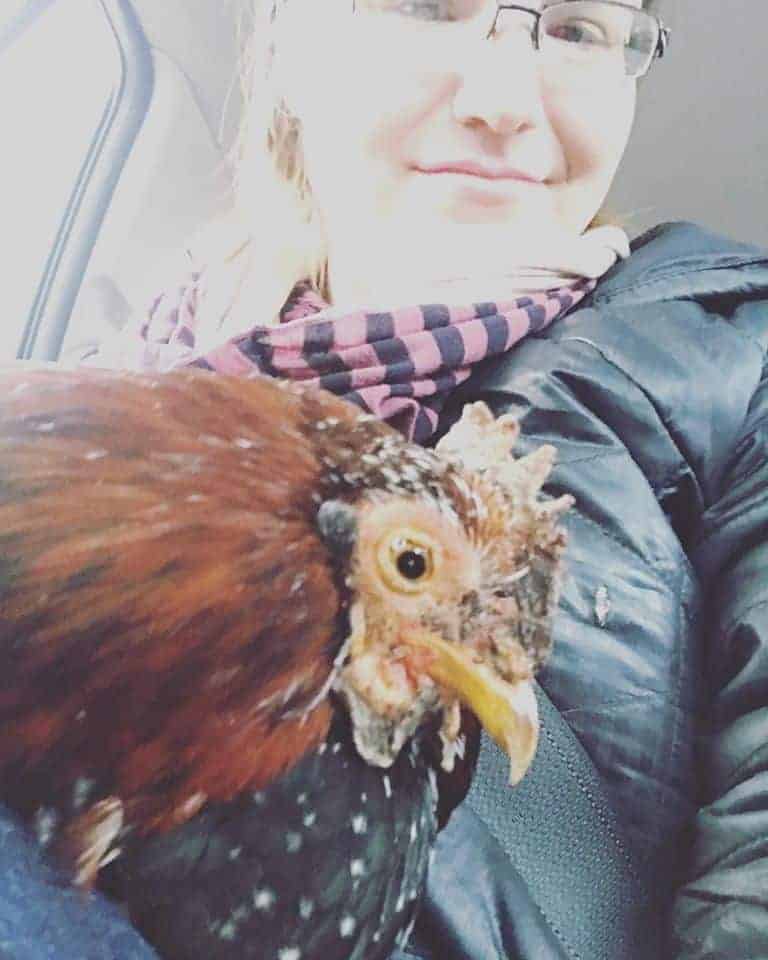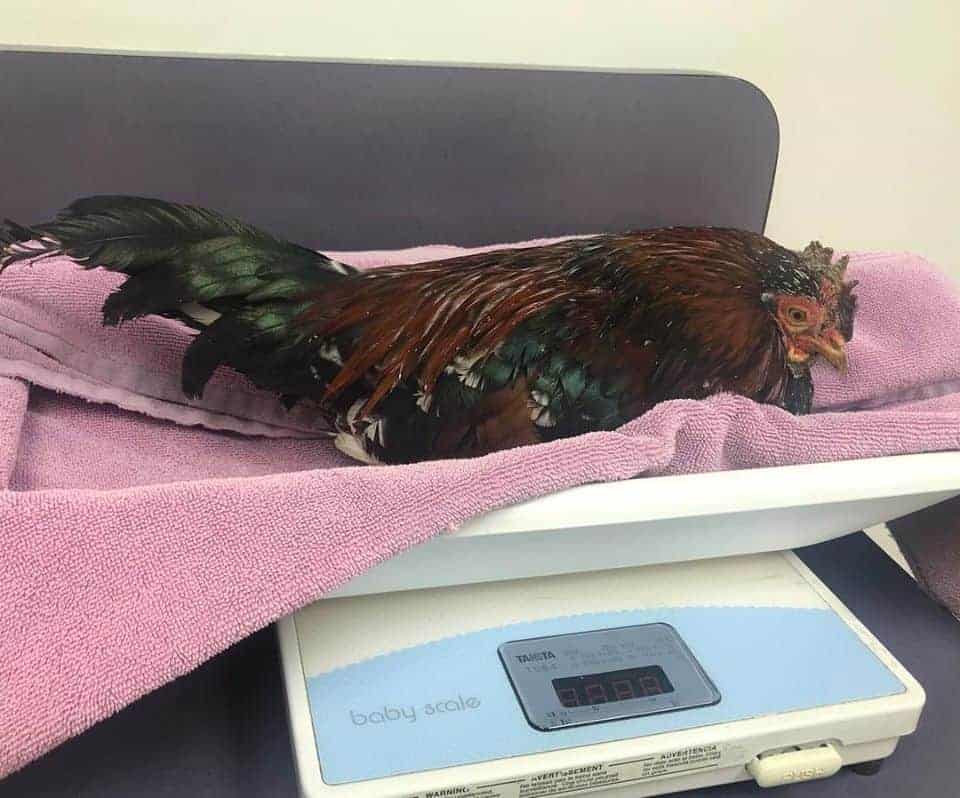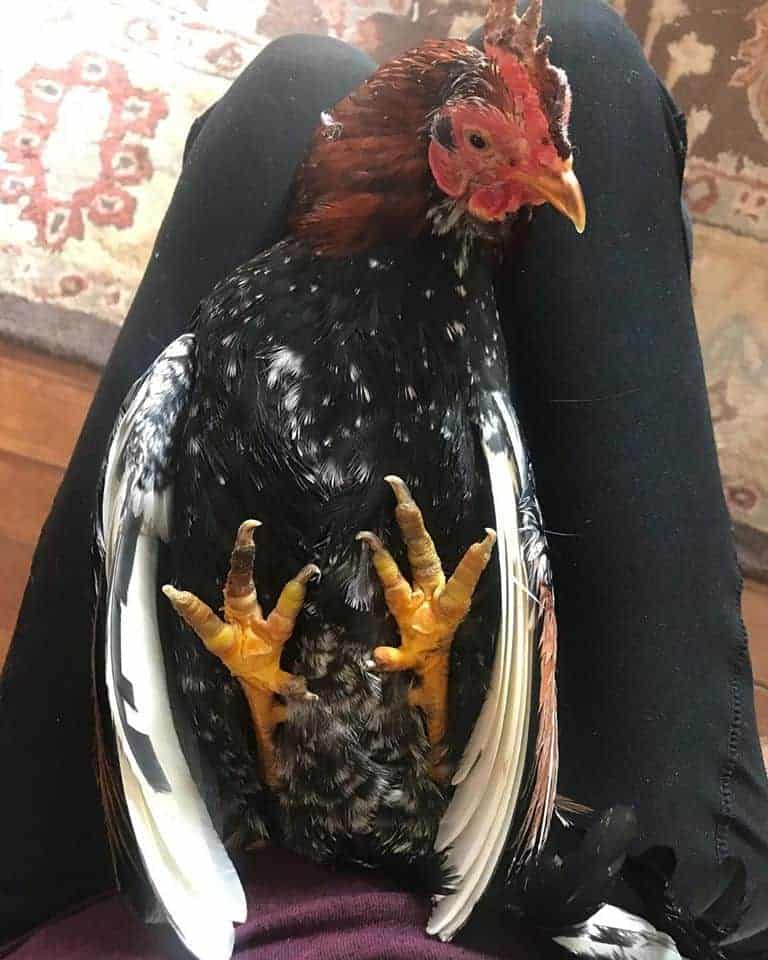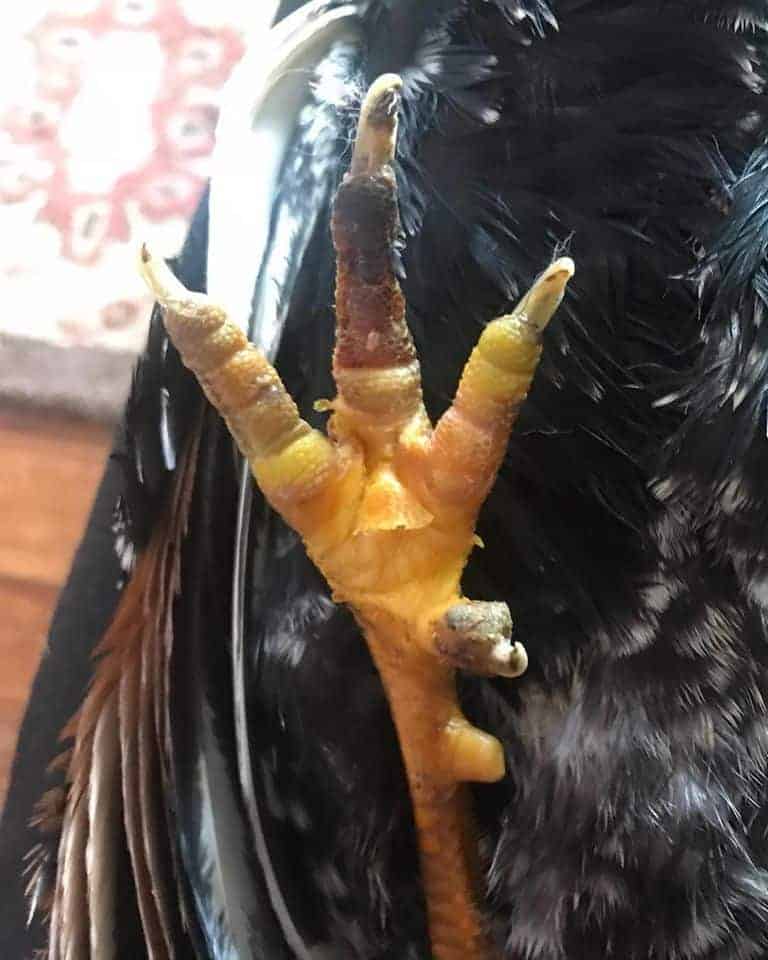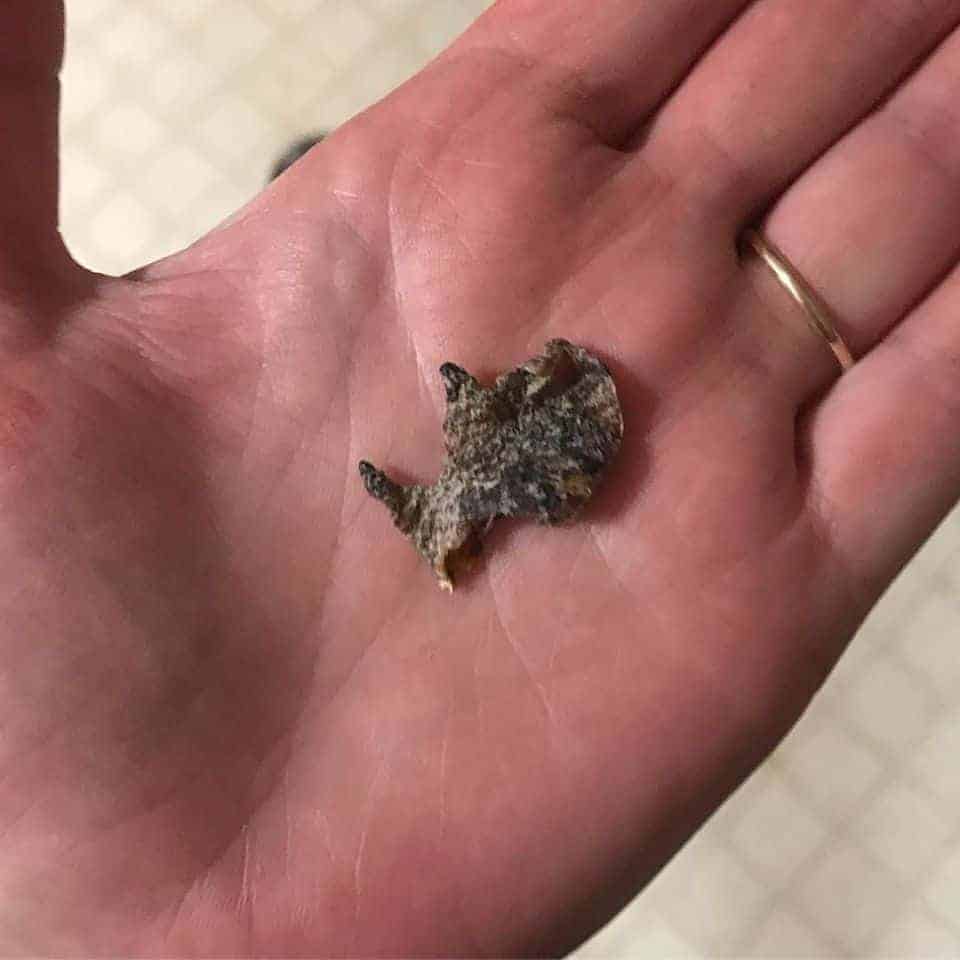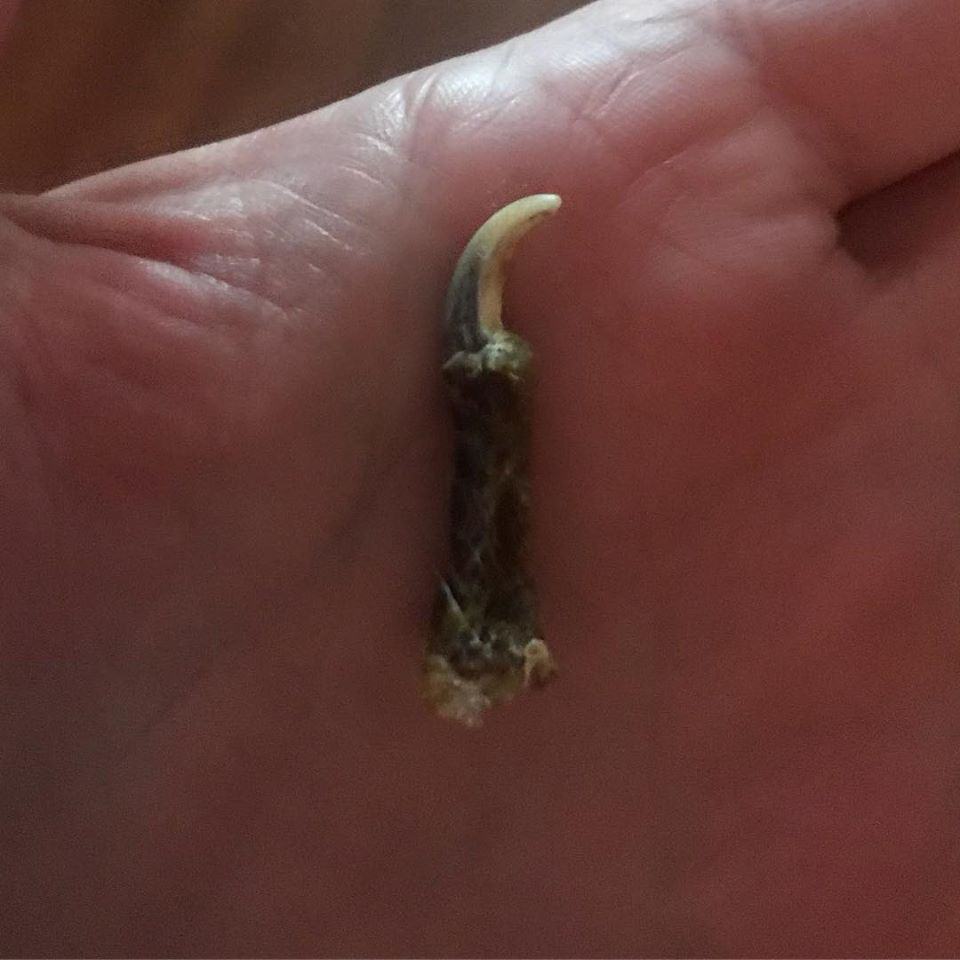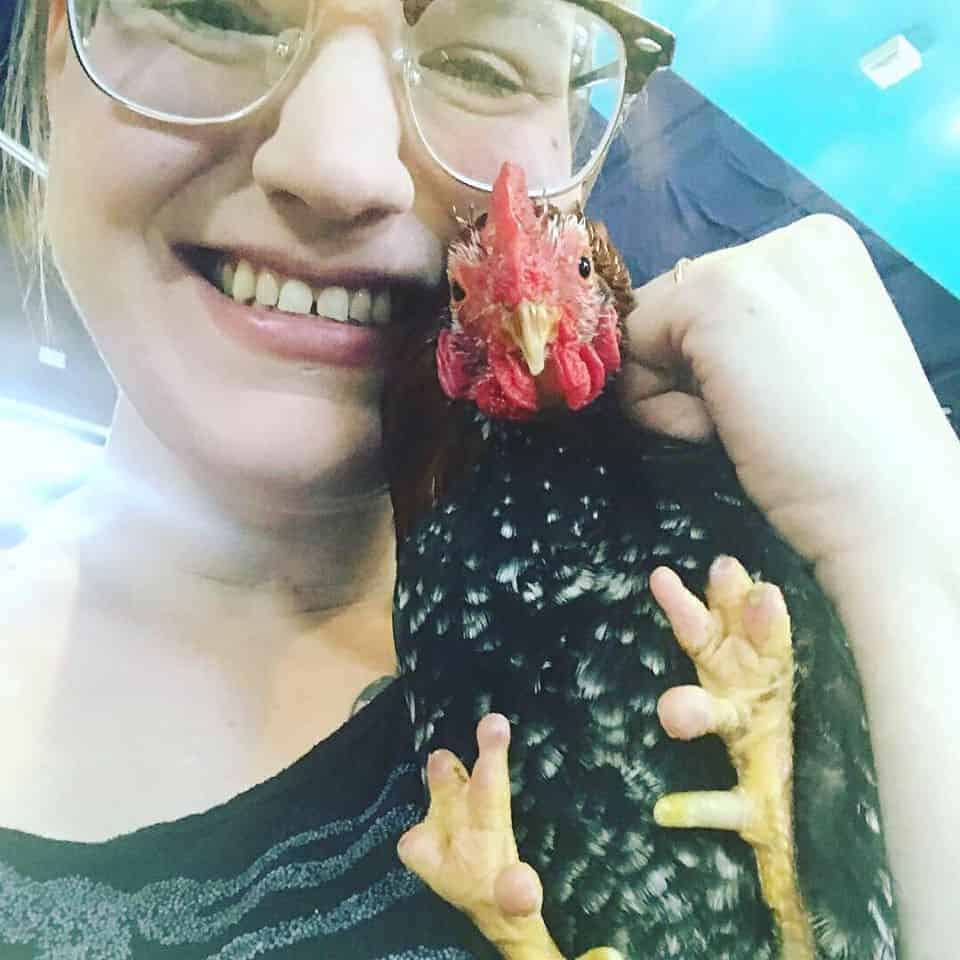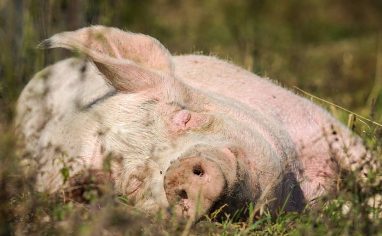

Content Warning
The following resource contains galleries that include graphic photos of birds suffering from frostbite damage. Also please note that all birds photographed in this resource were rescued with frostbite damage, for which they were promptly seen by their qualified veterinarians and received ongoing treatment, including ongoing vet care, from their respective sanctuaries.
Resource Goals
- To gain a greater understanding of chickens’ needs in cold weather conditions.
- To understand what measures can be taken to ensure chickens’ comfort and safety in cold temperatures.
- To understand what DOESN’T work to protect chickens from the cold, and why.
- To recognize and identify signs of frostbite and hypothermia, and learn what to do if these are observed.
Introduction
When it comes to the care of “farmed birds” generally, there are many misconceptions when it comes to cold weather, and in particular with respect to chickens. Chickens are the descendants of tropical red jungle fowl. As such, they are by nature best suited to live in environments that are warm, spacious, full of vegetation for hiding and roosting, as well as diverse plant and prey food sources. Most relevant to this resource – the native climate of tropical red jungle fowl is warm to hot as their native range spans from India across to southern China, Malaysia, Singapore, the Philippines and Indonesia.
While domesticatedAdapted over time (as by selective breeding) from a wild or natural state to life in close association with and to the benefit of humans chickens are virtually identical genetically to their tropical ancestors, they have been selectively bred over many years for the production of traits that benefit humans who consume them and their products. While thick feathering and smaller combs in some breeds may be a function of some human breeding programs around chickens, such traits are generally always valued secondarily to characteristics such as quick growth and excessive egg laying, which are prioritized most highly. This has created a serious misunderstanding around chickens’ needs in cold climates.
On the one hand, chickens’ inability to regulate their temperature in cold climates is an argument that is used by factory farmsIntensive agricultural operations that prioritize large volume animal product production using strict production methods, typically away from the public eye. to justify keeping birds in crowded and cramped conditions. On the other hand, there is a pervasive myth propounded by those who keep chickens on a smaller scale, such as in the backyard chicken community, that the more heavily feathered “heritage,” or supposed “cold hardy” types of chickens can exist in cold temperatures without supplemental heat. Both positions tend to discount the actual needs of the birds in question in favor of minimizing resource expenditure on their behalf, thus maximizing “production.”
In fact, prolonged exposure to freezing temperatures can weaken birds’ immune systems, can result in hypothermia, frostbite, and the consequential loss of body parts. Even in cases where no permanent damage is done to the birds, chickens that are forced to endure freezing conditions experience preventable discomfort. Offering birds compassionate care means that we must take steps to minimize all these potential issues and focus on providing conditions in which we not just meet the basic necessities of their care, but enable them to thrive, not merely survive.
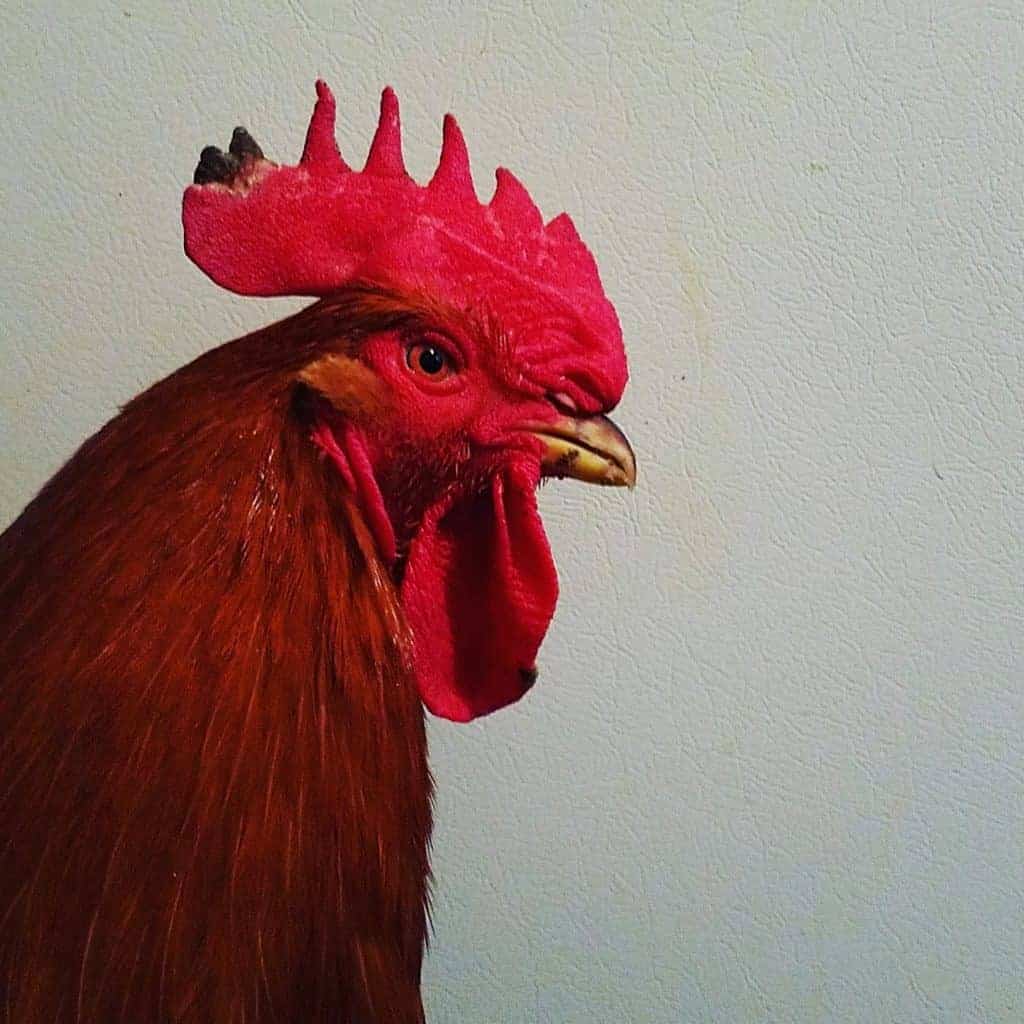
Other Farmed Bird Species And Extreme Cold
Please also note that while we focus here largely on chickens’ special susceptibility when it comes to exposure to cold weather conditions, other birds such as ducksUnless explicitly mentioned, we are referring to domesticated duck breeds, not wild ducks, who may have unique needs not covered by this resource., turkeysUnless explicitly mentioned, we are referring to domesticated turkey breeds, not wild turkeys, who may have unique needs not covered by this resource., geeseUnless explicitly mentioned, we are referring to domesticated goose breeds, not wild geese, who may have unique needs not covered by this resource., quails, guinea fowl, peafowl, and more are also vulnerable to the cold, hypothermia and frostbite. They too deserve careful observation and considerations when it comes to cold weather care, though their needs may differ somewhat from those of chickens. For instance, a duckUnless explicitly mentioned, we are referring to domesticated duck breeds, not wild ducks, who may have unique needs not covered by this resource. resident would need protection from the cold in addition to continued access to safe swimming water.
Ola’s left foot, with damage from frostbite on February 16, 2011. Photo courtesy of Chicken Run Rescue. While ducks differ from chickens in that they have some “built in” temperature regulation when it comes to cold, they can still be susceptible to damage from the cold, and factors such as access to water require careful attention in order to protect them from cold weather and frostbite damage. Ola’s right foot, with damage from frostbite on February 16, 2011. Photo courtesy of Chicken Run Rescue. Ola, a duck recovering from damage from frostbite on March 11, 2011. Photo courtesy of Chicken Run Rescue.
Ola the duck, rescued by Chicken Run Rescue with significant frostbite to both feet. Photos show initial frostbite damage, as well as what her feet looked like as the damage healed.
Factors in Considering Residents’ Comfort: General Guidelines and Resident Observation
As a general rule, based on their genetics and biology, chickens require protection in cold weather. According to the Minnesota Department of Agriculture, the optimal range of temperatures is from 55℉ to 70℉ (13°C- 21°C). While their resource on this subject is focused primarily on optimizing the “productivity” of birds versus maximizing their well-being, it is notable that this range of temperatures is much higher than what many have conventionally considered being “safe” for chickens. For those who closely monitor and provide compassionate care to their bird companions, discomfort in birds is visibly noticeable once temperatures hit around 32℉ (0°C). At this point, birds begin to lose their ability to regulate their body temperature. Once temperatures fall below 20℉ (-7°C), frostbite and hypothermia begin to set in. When considering safe temperatures, keep in mind the impact of wind chill, humidity, and precipitation, as all these factors can result in the temperature feeling much colder and can put individuals at risk of hypothermia and frostbite. A good general guideline is that if drinking water outdoors is frozen, it is too cold for your animal companions to be outside without having an option to retreat to warmer temperatures.
There are many factors that can contribute to whether or not a chicken is comfortable at certain temperatures. Regional climate seems to play a role to some extent. Just as some humans from colder climates may pride themselves on being able to withstand cold temperatures and joke about humans from warmer climates being overly sensitive to the cold (picture the human from Florida all bundled up on a “balmy” 50℉ day in Maine), anecdotally, it seems the same may be true of chickens. For example, when chickens have been transported from regions that were significantly warmer than the region they traveled to, they appeared to respond very differently than the chickens already living in the colder region and were uncomfortable at temperatures others seemed to do quite well in. However, this is only true to a certain extent. We are not implying that chickens living in areas with cold winters can become entirely acclimated to extreme cold, or that they are immune to frostbite and hypothermia.
Experienced caregivers will likely have a pretty good idea of what temperatures their residents are comfortable in, but should still be prepared to make adjustments based on their daily observations of residents. For example, if technically you think your residents should be fine having access to the outdoors on a particular day, but then you observe that all of your residents are staying inside, huddled up next to the heat source, they are telling you they are too cold. We’d suggest you close up their living spaceThe indoor or outdoor area where an animal resident lives, eats, and rests. (while still allowing for adequate ventilation) or increase the heat if possible. Alternatively, if based on bitterly cold outdoor temperatures, you decide it’s best to keep your residents inside for the day to prevent the risk of frostbite, but then you find that they are showing signs of being too warm, you should find a way to lower the indoor temperature without exposing your residents to the dangerous outdoor temps. This may be done by turning on a fan, opening a window that will not create a draft, and/or making adjustments to the heat source. Some heating sources have thermostats that can be adjusted, but others do not. In addition to watching your residents for signs of being too hot or too cold, it’s a good idea to keep a thermometer mounted inside your residents’ living space so you can monitor the actual temperature.
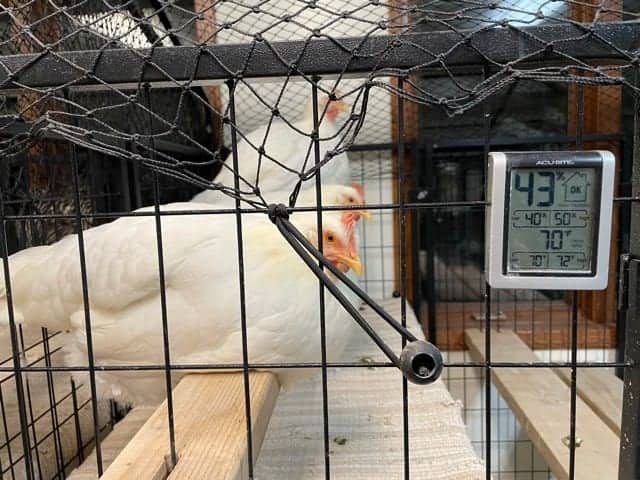
Signs of hypothermia in birds include shriveled and pale faces, combs and wattles. Birds may tuck their heads into their shoulders and under their wings, and fluff their feathers. They may shiver, huddle together, and become inactive. In any case, where this behavior is observed, the individuals exhibiting it should be moved into a warmer space, or steps should be taken to increase the temperature in their living space. Hypothermic birds are at risk of going into shock and dying quickly.
When it comes to frostbite, while it can develop in as short a period of time as ten minutes, it can take weeks for damage to become apparent, long after the injury has occurred. Extremities such as toes, combs, and wattles are most susceptible. It is important to monitor these body parts and check to see if they are feeling cold to the touch. If for example, you find that toes are very cold to the touch but areas of the feet and legs closer to the body are much warmer, you must take action to prevent further damage. In the case of birds rescued from extreme temperature conditions, we always recommend seeking qualified veterinary care as soon as possible. You can read more about frostbite here.
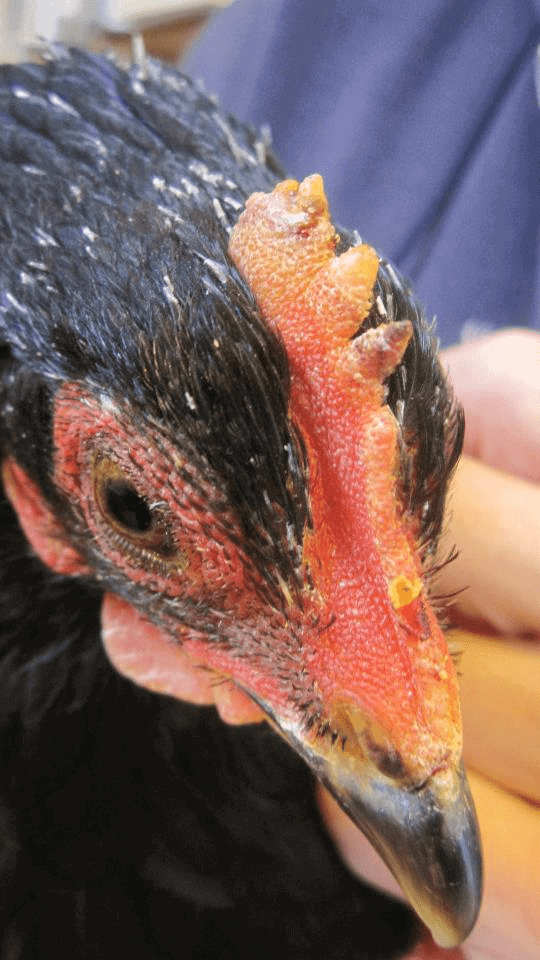
Measures to Ensure Resident Well Being In Extreme Cold
Providing Supplemental Heat
Heat Sources And Polytetrafluoroethylene Toxicosis
Be aware that some glass bulb heat lamps (which we strongly advise against using) and radiators are made with substances containing polytetrafluoroethylene (PTFE). At high temperatures, these heat sources can put out highly toxic fumes, resulting in Polytetrafluoroethylene Toxicosis (also known as Teflon Flu and Polymer Fume Fever). Items containing PTFE or Teflon should never be used around birds. If you have doubts about any heater, radiator, or bulbs, contact the manufacturer directly to ensure that PTFE is not used in the product, prior to using it around birds.
In cold weather, birds will always require extra calories and fresh water at all times. In general, if the weather poses a risk of frostbite and hypothermia to humans, birds should be kept indoors, or in heated sheltered spaces such as garages or barns. In such conditions, if they are let out, they should not be left in such temperatures longer than is safe for humans. It is also important to note that chickens can also do very well as indoor companions in human homes, and they will be much more comfortable in your home provided that you take precautions for their care indoors.
If you cannot bring your birds into your home, at the very least they must be provided with safe heating. In terms of safety considerations, we strongly recommend against the use of heat lamps whenever possible because they come with serious risks and have been known to cause fires. If for some reason you feel a heat lamp is your only option to keep your residents safe in cold temperatures, be sure to use a ceramic bulb heat lamp instead of a glass bulb style. Ceramic heat lamps still carry risk, but are generally a safer option than glass bulbs. Be sure to hang it at least 3 feet above any bedding, and make sure it is firmly secured by a chain and not just the cord. Inspect the heat lamp regularly and keep it clean and free of dust. Please note that even when these precautions are taken, accidents can happen and the results can be deadly and devastating.
Some rescuers and sanctuaries have used microwavable heat pads and hot water bottles for supplemental heat in small coop spaces. These must be closely monitored and wrapped carefully to prevent birds from being burned from hot spots, particularly when it comes to heating pads. They also must be checked regularly to make sure that they are constantly providing warmth, and we would strongly recommend a thermometer that can alert caregivers with respect to temperature drops or spikes. Generally, we would not recommend their use unless they are monitored very frequently and regularly by caretakers who are constantly on site. Again, PTFE concerns must be considered carefully with such products. Instead, consider the below options.
Radiant panel heaters can be a safe option for smaller coops. For larger shed or barn-style coops, oil-filled radiators can be an option (not to be confused with oil-burning heaters)! The oil in oil-filled radiators is not burned, thus they do not produce fumes during normal operation.
Both Chicken Run Rescue and Woodstock Farm Sanctuary recommend oil-filled electric radiators (specifically the DeLonghi brand oil-filled radiator space heater) and in very cold climates they may do a better job of keeping a space comfortable, but you must take certain precautions to prevent birds from being burned and to mitigate any fire risk. Because models and specifications can change over time, even within brands, it is still important to check with a manufacturer to make sure that the heater you are using does not contain PTFEs.
Many heaters have thermostats that help to regulate temperatures. As mentioned above, it is a good idea to install thermometers and humidity monitors inside residents’ living areas to monitor exact temperatures. Heaters should be either caged or mounted in a manner so as to protect birds from direct contact, to keep bedding materials away, and also safely secured so that they cannot tip. Fully enclosing the radiator in a framed box, and possibly also elevating the system onto a sturdy platform, can be a good option. Because any use of electricity – even in human homes and with the safest of devices – involves a fire risk, it is strongly recommended to also utilize smoke alarms and other safety alerts that can be linked to human homes when heaters are in use.
Be Sure To Protect Heat Sources And Cords From Other Residents!
If your bird residents live with another species, make sure that they too are unable to knock over heat sources or chew electrical cords. Larger residents, particularly goats or pigs, could pose a significant challenge in terms of safely providing a heat source. For further information on safe cohabitation for chickens, please see this resource.
When using any kind of heater, it is important to do a thorough inspection after taking them out of storage for the cold season. Inspect cords for possible damage, remove any accumulated dust or cobwebs, and do a “test run” to ensure that the heater is actually still working properly before you need it. Discovering a heater is out of order when temperatures are falling is less than ideal. Woodstock Farm Sanctuary also points out that electric oil-filled radiators use quite a bit of energy, so you should determine in advance if you need an electrician to install additional breakers. This preventative maintenance to resident living areas is also an important measure to take in advance of season changes involving dropping temperatures. We always advise against the use of power strips or extension cords. In order to reduce the risk of fire, it is important to only use an electric radiator if you can plug it directly into an outlet.
In addition to providing a heat source, you will need to prevent any drafts while also ensuring proper ventilation. It can be helpful to have small, chicken-sized doors that are used in the colder months to allow birds outside access when appropriate. This can cut down on the draft caused by a larger door. If there is room to do so, the addition of windbreak, such as by placing a bale of straw in front of the door, can block the draft created by the open door. Again, you must watch your residents closely. If you find that you cannot maintain a comfortable indoor temperature while providing outdoor access, then it’s best to keep your residents closed in for the day.
You never want to overcrowd a space, but keeping indoor living space on the fuller side can help keep the space warm. If you have a few birds in a very large space, you may find it is difficult to keep the space at a suitable temperature.
If the outdoor temperature is warm enough for your residents to be comfortable with outdoor access, but there is still snow on the ground, be sure to shovel a large area outside their door so they can be outside without having to stand in the snow. Covering the area with straw or leaves will also help keep them comfortable. The key is to allow birds to choose if they want to go outside or stay inside near a heat source.
Be sure to pay close attention to flock dynamics. An individual who is being bullied may stay outside, despite the cold weather, simply to get away from a flockmate. This could result in frostbite or hypothermia despite technically having access to a heated space. In cases such as this, alternative living arrangements or using partitions to divide the space will be necessary.
Video Resource: Chicken Resident Snow And Temperature Preferences In Action
Contingency Planning for Loss of Power
Loss of power in the case of extreme weather conditions is always a concern when your residents are reliant on heat sources that are dependent on a consistent power supply. With smaller flocks, moving all birds into a home or sanctuary office space may be an option. For sanctuaries with larger populations of avian residents, you may need to make additional contingency plans.
Depending on the reliability of your organization’s power source, you may need to invest in a gas-powered generator to keep on hand for emergencies. While a smaller generator may not power everything you want at your sanctuary, it can be an important investment to keep on hand so that you can continue to heat resident living spaces in the event of a power outage. Just be sure that you never use the generator indoors, and always operate it in a well-ventilated area on a piece of land that is safe from any kind of fire risk!
For a more eco-friendly (but a more expensive) option, your sanctuary could invest in solar or wind energy, along with a battery backup system, which could also keep your electricity bills lower in addition to being available in times of need! These alternative energy projects may be excellent for sanctuaries looking for future improvements to strive towards.
The Question of Sweaters for Birds
Many avian species, including chickens and turkeys, puff up their feathers in order to keep warm. This allows them to trap air under their feathers which helps to insulate them. If they are put into a sweater, they are prevented from being able to do this, which actually can make them colder than they would be absent from this intervention.
In the case of individuals who are not fully feathered, such as those who have had a late molt, a medical procedure that required feathers to be removed, or birds such as silkies whose feathering makes them particularly susceptible to cold and wet conditions, a sweater may be beneficial temporarily. However, it is important to note that the addition of a sweater will still not protect areas of the body that are most vulnerable to frostbite, such as combs, wattles, and feet.
Sweaters also come with other challenges. For example, they can be a great hiding spot for external parasites. If they become damp, they can contribute to chilling the resident. Furthermore, residents wearing sweaters can be at risk of getting caught on things, potentially putting them at risk of strangulation or injury. Finally, some individuals may not enjoy wearing a sweater, and it is also possible that a sweater-wearing individual can become a target for bullying behaviors by flockmates. In general, it is likely better to keep individuals with large portions of exposed skin, or individuals with feathers like silkies indoors during cold spells.
Bedding In Winter: Debunking Deep Litter
Other considerations with respect to cold temperatures include bedding and humidity. It is important to ensure that birds have extra-warm, clean, and dry bedding during cold seasons. Ensuring that the bedding is clean is critically important, so that moisture from droppings does not contribute to additional humidity in the coop. Extra bedding can help provide warmth, but be sure you do not add so much that it makes it difficult for birds to walk. It may be helpful to identify certain areas that are not major walkways and add even more bedding to these areas, giving chickens the opportunity to nestle down in these areas without making movement within the space difficult.
One common recommendation seen in backyard chicken-keeping resources is the “deep litter method.” This method essentially consists of allowing old bedding to accumulate inside the coop and run and piling new bedding on top of it. The theory is that as older bedding and bird waste compost under newer, the heat generated will warm the coop and run. The problem with this theory is that accumulated waste is unsafe for chickens. Fumes from decomposing bedding can be harmful, and bacterial buildup can cause illness. Damp bedding, especially straw, can become a breeding ground for mold and fungus and can increase the risk of diseases such as aspergillosis. Furthermore, damp and decomposing bedding and waste contribute to the problem of humidity in the coop, which only worsens the issues that accompany cold temperatures. Condensation and moisture in their housing can actually cause birds to lose more body heat, more quickly, and also contributes significantly to frostbite. Providing supplemental heat to your residents is a much more controllable and sanitary way of keeping them warm during extreme cold.
Humidity Control and Ventilation
When it comes to controlling humidity in outbuilding-type coops, aside from keeping bedding clean, you can also provide dehumidifiers in your coop in order to prevent the buildup of harmful condensation and moisture from both droppings and the birds’ breath. Cordless rechargeable dehumidifiers are available that can be hung inside of coops, but it is important to make sure that these are out of reach of curious birds, and that they are monitored to make sure that they are charged sufficiently.
Some caretakers recommend the use of nipple waterers for chickens, reasoning that it can help decrease humidity in the air by removing an open source of water, and also by avoiding spills. They also suggest that it can help avoid frostbite by preventing birds from dipping their wattles into water. While this kind of water source may be helpful in those regards, if chickens are not acclimated and comfortable with them, they may not consume enough water and can become dehydrated. If such waterers are employed, it is critically important that caregivers spend time observing the chickens using them in order to ensure that they are drinking enough and that any new residents introduced to the flock are monitored to make sure that they know how to use them, and are comfortable doing so.
Though it may seem counterintuitive, adequate ventilation preventing an excessive buildup of humidity and moisture in the coop is also important when it comes to chicken housing in extremely cold temperatures. Proper ventilation is imperative in order to prevent serious health issues such as aspergillosis and other respiratory issues. Without proper ventilation, spaces can become too humid or wet and ammonia levels can rise. Keep in mind that if you live in a colder climate, you will need to find a way to provide adequate ventilation without creating too much of a draft. Ways to keep living spaces ventilated might include ventilated roofs, and windows that are above bird level to prevent drafts from impacting residents. Keep in mind that vents, windows, exhaust fans, etc. must all be properly predator-proofed in order to ensure resident safety.
It is also important to keep in mind that climate control needs and equipment will differ significantly between a freestanding outbuilding coop and a living space within the interior of a home or a building. As noted above, humidity from condensation and the birds’ respiration can cause problems in such a setup.
If you keep chicken residents in the interior of your home or a building with internal temperature control, it is possible for humidity to drop to unhealthy levels during the heating season. In setups like these, maintaining routine hygiene control and also monitoring humidity is also important – but you may need to make sure your birds are getting sufficient humidity. Chicken Run Rescue’s veterinarians recommend that they keep their indoor chickens’ temperatures at 65℉ (18°C) and that humidity levels be maintained at approximately 50% in order to simulate chickens’ native environment as closely as possible and maintain immune support and prevent respiratory problems, especially during stressful winter confinement during cold months.
A Note on the Use of Vaseline on Combs and Wattles
Another common backyard chickenThe raising of chickens primarily for the consumption of their eggs and/or flesh, typically in a non-agricultural environment. recommendation when it comes to the prevention of frostbite is that the application of Vaseline or salves to combs and wattles works as a preventative measure. You may even encounter this recommendation in the context of humans doing winter sports, such as skiing. However, there is no proof that Vaseline reduces the risk of frostbite, and in fact, many seasoned winter sports aficionados and even polar explorers have long noted that Vaseline seems to be more problematic than helpful.
For example, in recounting the stories of polar exploration, Wilderness and Environmental Magazine recounts that “Macklin [a surgeon on two of Ernest Shackleton, an Anglo-Irish Antarctic explorer’s expeditions] accepted that “[v]aseline and glycerine have been used on the face to protect it from strong winds, and apparently with success,” but elsewhere warned, “[t]he application of Vaseline or ointment is the worst treatment possible, especially if the part is liable to be again exposed to cold” and describes experiments that he had done to confirm that. More recent work supports Macklin’s view and suggests that although petroleum jelly makes the skin feel warmer, it has no effect on skin temperature, and by creating a false sense of security, might lead to an increased risk of frostbite through neglect of efficient alternative measures. Rubbing fat into the skin also makes it more difficult to see frostbite.”
Furthermore, it’s important to remember that the “normal” context of a human using Vaseline or other salves for the purpose of preventing frostbite is quite different from that of a chicken. A human engaging in an outdoor activity (outside of Antarctic exploration!) likely has the option to retreat to an indoor and heated space, whereas chickens who are kept in cold temperatures without supplemental heat or protection do not have this choice.
Using Vaseline as a “preventative” does not obviate the need to provide your residents with the option to retreat to warmer temperatures where they may be more comfortable, or the need to offer them additional protection when temperatures are dangerously cold. The use of Vaseline may arguably exacerbate the risk of frostbite, because Vaseline and other salves in fact trap moisture into tissue, making it more prone to freezing. Finally, in cold enough temperatures, Vaseline and other products may potentially freeze themselves, making matters even worse. Vaseline also can be extremely messy, and if it gets into feathers, it can make it difficult for chickens to preen themselves, and also can interfere with proper feather growth. In short, it is always better to take appropriate and effective measures against cold weather damage, versus dealing with the aftermath.
Simply put, there is no “easy quick” fix when it comes to proper compassionate cold weather care for birds, but providing birds with sufficient shelter, heat, clean bedding, ventilation, and taking measures against excess humidity will do wonders for ensuring the comfort and safety of your avian residents in cold temperatures.
A Note on Enrichment
If residents must stay indoors, consider expanding enrichment! In some regions of the world, it can become so cold or icy that it is not safe to allow residents to be in their outdoor living spaces, either during certain parts of the day or even for weeks on end. At times like these, it’s critical to consider that the individuals in your care will need additional enrichment to improve their quality of life, stave off boredom, and reduce confrontationalBehaviors such as chasing, cornering, biting, kicking, problematic mounting, or otherwise engaging in consistent behavior that may cause mental or physical discomfort or injury to another individual, or using these behaviors to block an individual's access to resources such as food, water, shade, shelter, or other residents. behaviors towards their flockmates. Consider exploring our chicken enrichment resource to find appropriate enrichment opportunities!
What to Do When You Encounter Frostbite and Hypothermia
Even caretakers who observe all appropriate measures when it comes to cold weather compassionate care may well still encounter birds who suffer from the impacts of frostbite and hypothermia. Rescuers in cold climates frequently encounter dumped birds who have suffered damage from exposure and must take measures to address this to help these birds recover. The most critical action you can take for such a bird is to get them into warm temperatures immediately. You will also want to observe all the steps necessary when assessing new arrivals. General guidance on how to manage new arrivals can be found here, and specific guidance on how to perform a chicken health checkThe Open Sanctuary Project uses the term "health check" to describe health evaluations performed by caregivers who are not licensed veterinarians. While regular health checks are an important part of animal care, they are not meant to be a replacement for a physical exam performed by a licensed veterinarian. can be found here.
Unfortunately, frostbite can take weeks to manifest after the damage has been done, as noted above. If you observe swelling of digits, combs, and wattles, or feel tissue on extremities that is cold to the touch while areas closer to the body are significantly warmer, you are likely seeing frostbite damage. More advanced frostbite can manifest with tissues changing color to white, gray, yellow, or blue-grey. You may also note blisters. Limps may also be indicators of frostbite damage, even absent the above-mentioned signs. You may also note bleeding combs and wattles where blood vessels have ruptured or exposed skin tissue on heads or feet which turn yellow, then black and crusty as the blood supply to the area shuts down.
It is critically important that caretakers not minimize the impact of potential frostbite damage. Birds who have been exposed to extreme cold may not “just” lose combs and wattles to frostbites, but also entire toes, feet, and legs!

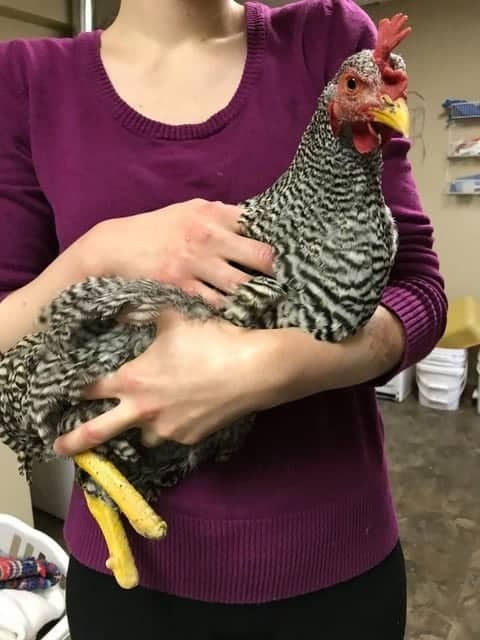
Cal showing evidence of frostbite on rescue, on March 17, 2011. All photos courtesy of Chicken Run Rescue. Cal on March 19, 2011. This is early stage frostbite. The toes swell and water blisters form in the softer flesh areas. These photos are in chronological order so you can see how the injury progresses. It is not reversible. Where the tissue dies determines where the amputations are done. Swelling and scabbing on Cal’s feet progresses on March 21, 2011. Cal’s feet continue to swell, and the extremities of his toes begin to blacken and shrivel as frostbite damaged tissue necrotizes on March 28, 2011. Cal, a very good boy, undergoing ongoing treatment for his frostbite on April 5, 2011. On April 5, 2011, dead skin begins to slough off of Cal’s feet as his frostbite damage progresses. The underside of one of Cal’s feet on April 15, 2011. A view of the top of Cal’s feet on April 15, 2011. Swelling continues up his legs, and his toes continue to stiffen, shrivel and necrotize. On April 18, 2011, Cal after his first amputation. One foot at a time was amputated. At this point it was clear where the dead tissue started and the healthy tissue remained on Cal’s right foot. Cal on May 15, 2011 after his second amputation. Both of his feet were now gone. He was so cute that it hard to imagine the agony and heartbreak he survived. Cal on May 26, 2011, shortly after his second amputation. His first amputation was healing nicely- there was enough skin for vet to close over the bone on one foot, but he was not so lucky on the other, and that was a very tricky surgery. His second amputation site took longer to heal, but did heal nicely. Cal on August 9, 2012, fully healed. Footless Cal – Triumphant Survivor. Image courtesy of © Sarah Beth Photography
Cal, a very special rooster rescued by Chicken Run Rescue, on his long journey recovering from frostbite. The photos are illustrative of how long-term the impacts from frostbite are, and how damage from frostbite manifests increasingly over time.
We strongly recommend that after any bird who has been subjected to cold temperatures is brought into safety and warm temperatures and given an initial health check, they then are brought to a skilled avian veterinarian for assessment. Because of the long course of progression with frostbite, it can be very difficult to determine how far the damage has gone. At times, there can be so much damage and dead tissue from frostbite, that amputation may be recommended. Multiple sanctuaries in cold climates have residents who have lost body parts to frostbite. With proper care, these individuals can live fulfilling and happy lives upon recovery, but oversight from a qualified avian veterinarian is absolutely necessary.
Wesley, a rooster after rescue from extreme temperatures during “Pioneer Day” in Ridgeland, Wisconsin with caretaker Quincy Markowitz. Wesley’s comb and wattles already show telltale darkening indicative of severe frostbite. All photos courtesy of Farm Bird Sanctuary. Wesley at his initial veterinary examination. A few days after rescue, Wesley began limping which showed that his frostbite was much more extensive than to his comb and wattles. Wesley’s feet begin to show signs of frostbite including blackening of his toes and sloughing of the skin. His toes did not begin to blacken until around a week after his rescue. A close up of Wesley’s right foot, showing the progression of frostbite damage on his toes and the bottom of his foot. Wesley’s frostbitten comb eventually blackened and fell off entirely. As with his comb, as the frostbite damaged tissue necrotized, it stiffened and fell off. This is one of his toes. During this process, caregivers must monitor closely for bleeding and consult their veterinarians to seek pain medication and potentially antibiotics or surgical intervention. Frostbite ultimately took all of Wesley’s toes and most of his comb, limiting his ability to perch without accommodation from his caregivers. Here you can see what his feet look like after his experience with frostbite, along with his caregiver Quincy Markowitz.
Wesley, a wonderful rooster rescued by Farm Bird Sanctuary from a chicken toss event in Ridgeland, Wisconsin. These photos show the progression over time of frostbite damage to Wesley’s comba fleshy crest on the head of the domestic chicken and other domesticated birds and toes.
Frostbite is a VERY painful condition, and your veterinarian can prescribe appropriate pain medication as frostbite damage runs its course. We recommend that you not only ask for internal pain relievers from your vet, but also for any ointments that may help. Some rescuers and sanctuaries have had good results with silver sulfadiazine cream for healing and pain relief. Veterinarians may also be able to offer appropriate dietary supplements and options such as laser therapy to assist in healing. As frostbitten tissue becomes necrotic and falls away, birds may also require antibiotics to prevent infection. We further recommend that any bird subjected to extreme cold and frostbite be housed indoors until the extent of their injury is known, and they have been sufficiently treated for it, and have had follow-up vet care to confirm their recovery.
Please keep in mind that veterinary care is also critical in these kinds of cases because birds suffering from frostbite and hypothermia may well have associated conditions, such as upper respiratory or other kinds of infection. With any dumped bird, it is safe to assume that they may be suffering from a myriad of ailments ranging from infection to internal or external parasitic infestation and other issues, so it is always important to get dumped birds to the vet as soon as possible.
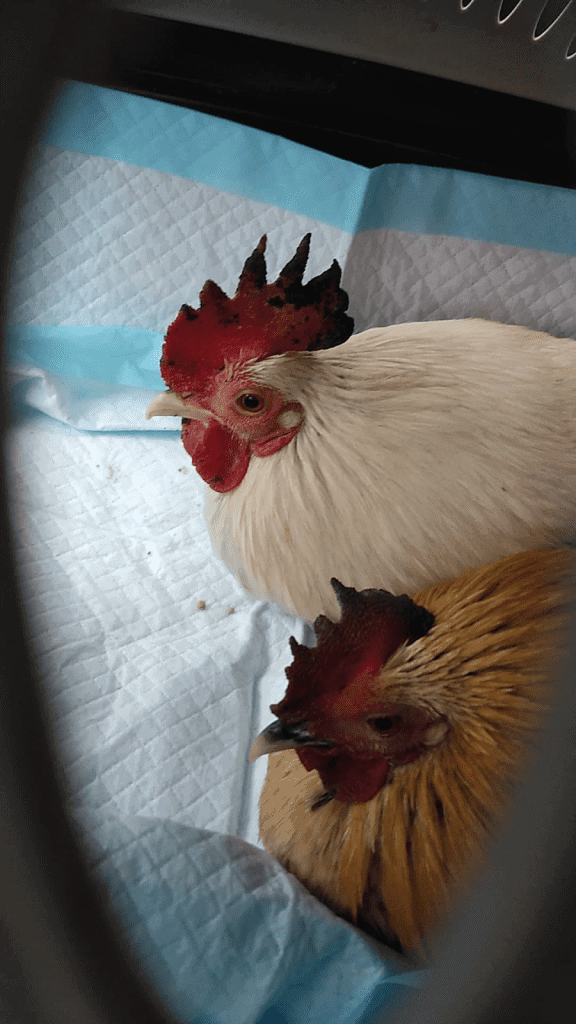
Summary
The best course of action when it comes to cold temperatures is always to take preventative measures to ensure the safety and comfort of your avian residents, whether they be chickens, ducks, geese, turkeys, quails or others! Chickens in particular require heat and protection from the elements during cold weather. Always pay close attention to the weather forecast in your area so that you can prepare in advance for significant temperature fluctuations or any periods of extreme cold (please note that “extreme” will mean different things in different areas – some chickens might be quite comfortable in 40-degree F weather, while others may find this too cold). Also, be sure to pay attention to the “real feel” in addition to the actual temperature. During cold weather, to ensure the comfort of your bird residents, you will need to take necessary precautions such as:
- Providing safe supplemental heat;
- Providing extra clean bedding;
- Monitoring humidity;
- Appropriately managing ventilation;
- Bringing birds into your home in extreme conditions; and
- Being particularly vigilant about monitoring for any signs of temperature related health issues.
Action Steps:
- Keep track of weather conditions and forecasts.
- Practice careful observation of residents as weather conditions change.
- Before temperatures take a downturn, do safety checks of all infrastructure and electrical devices in order to ensure everything is in proper working order.
- Take measures to ensure residents have sufficient warmth to maintain their comfort, that humidity in living spaces is minimized, that bedding is clean and sufficient, and that there is adequate ventilation.
- When you do encounter birds exhibiting signs of hypothermia or frostbite, bring them into warmth immediately. If the individual is stable, you can conduct a health check and seek veterinary advice for further treatment, but some individuals may require urgent and immediate veterinary care.
Article Acknowledgments:
This resource could not have been created without the pioneering work and shared knowledge of compassionate chicken advocates including Chicken Run Rescue, Farm Bird Sanctuary, Woodstock Farm Sanctuary, and the administrators of Vegans with Chickens.
SOURCES:
Poultry Your Way: A Guide to Management Alternatives for the Upper Midwest | Minnesota Department of Agriculture (Non-Compassionate Source)
Non-Compassionate Source?
If a source includes the (Non-Compassionate Source) tag, it means that we do not endorse that particular source’s views about animals, even if some of their insights are valuable from a care perspective. See a more detailed explanation here.




